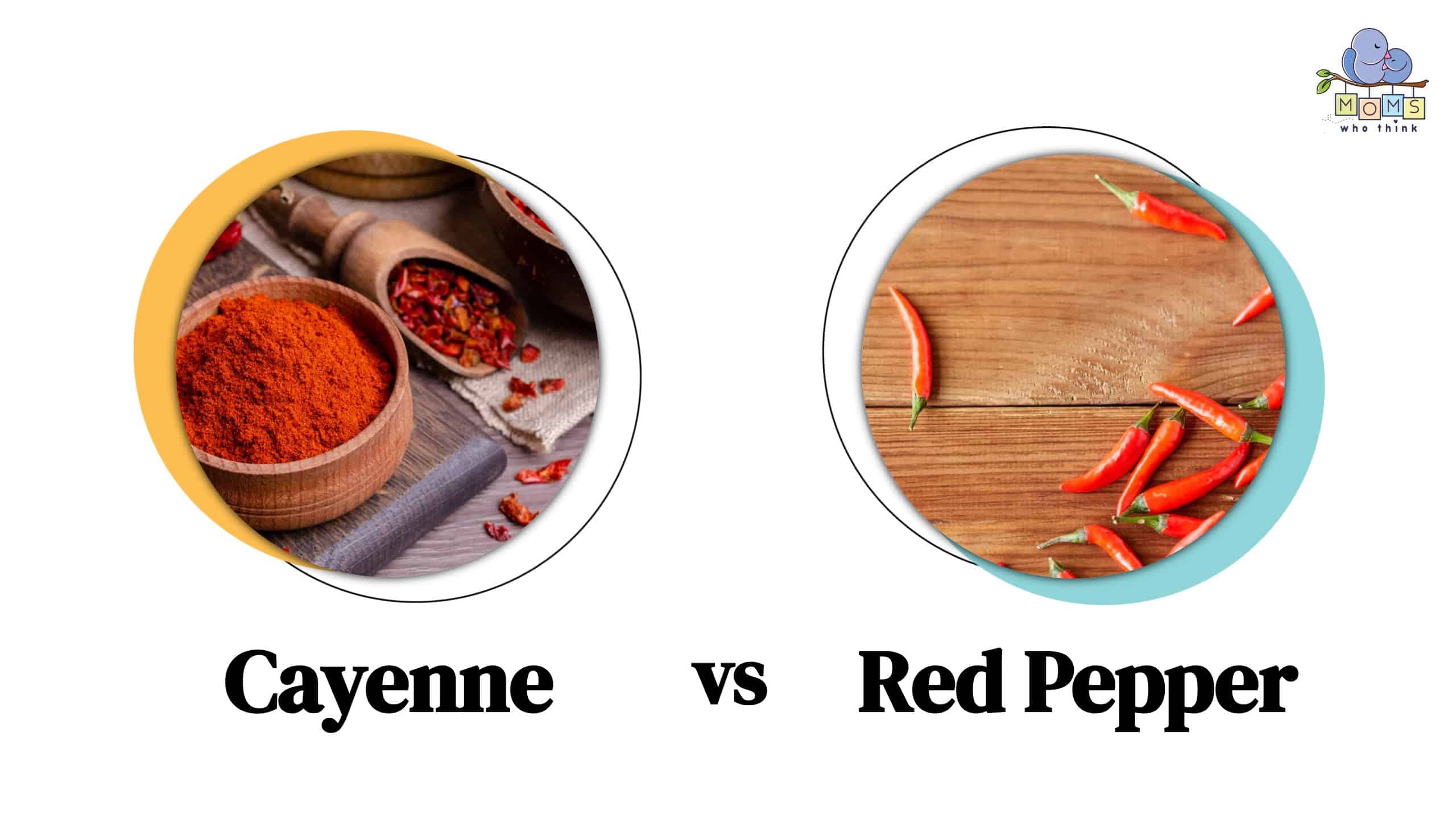Red pepper and cayenne pepper are both widely used seasonings. Both are fantastic ways to spice up and color your cooking.
When it comes to spices, many of the names can start to seem similar. Beginners often mistake one for the other as a result of this. Many cooks are unsure if there is any difference between these two components because some recipes may even utilize them interchangeably.
A spicier variety of red pepper is referred to as cayenne pepper by some producers. What distinguishes red pepper from cayenne pepper, then? Read on.
- The must-have convenient reference guide for every home cook!
- Includes more than 8,000 substitutions for ingredients, cookware, and techniques.
- Save time and money on by avoiding trips to grab that "missing" ingredient you don't really need.
Cayenne vs. Red Pepper: What Are the Differences?
Origin
The “Cayenne” variety of the species Capsicum is called cayenne pepper. A dash of cayenne pepper is the “Cayenne” form of the genera Capsicum annum, a flowering plant in the Solanaceae family. This family is also called the nightshade family. It usually grows up to 4 feet tall and makes peppers that are red, orange, yellow, or green when they are ready. It also produces white to purplish-colored flowers. The plant also has bell pepper and jalapeno varieties.
When you hear the term red pepper, remember that it refers to a wide variety of peppers. People use red pepper to designate the other genus Capsicum members, such as bell peppers, Red Savina, and cayenne pepper.
Appearance
Cayenne pepper grows typically up to six inches. Their skin has wrinkles and curls at the end. They appear slim at the end.
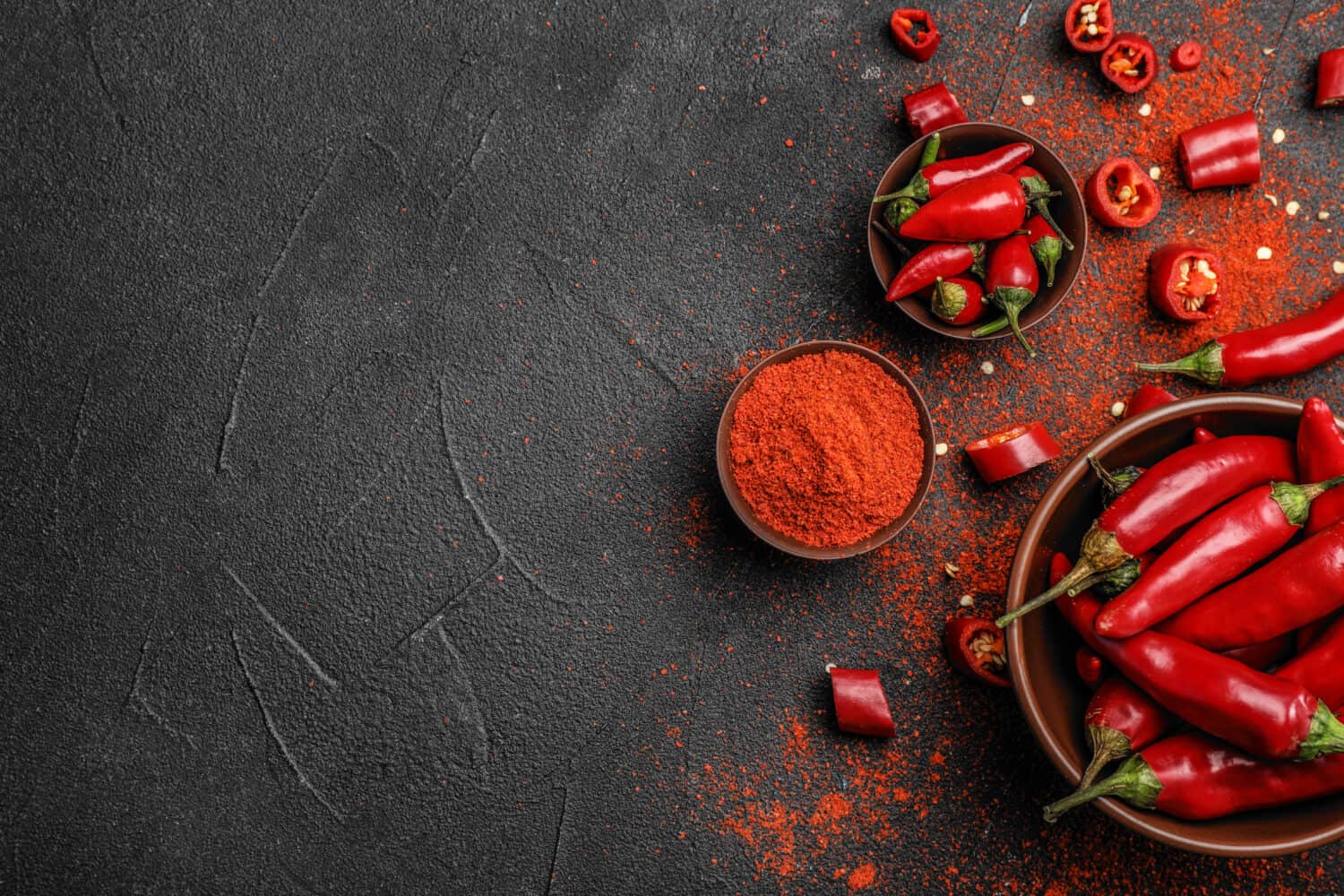
Both cayenne and red peppers offer a spicy kick to your dishes!
©New Africa/Shutterstock.com
Cayenne and bell peppers are members of the same kind of peppers. Bell peppers are distinguished from cayenne peppers by their blocky bell form and bigger diameter. Other “red peppers” can also vary in size and shape.
Heat
Capsaicin, a chemical, is what makes peppers have different hot flavors. The more the capsaicin content, the hotter the pepper will be. The red bell pepper lacks any spicy flavor whatsoever. Cayenne peppers typically score between 30,000 and 50,000 SHU on the Scoville scale, which is used to determine the spiciness of chili peppers.
Some red peppers from the Capsicum Chinese species, however, are among the hottest in the world, with a Scoville heat index of over 2 million.
Uses
Red pepper may add a little heat to any dish. Consider incorporating red chili flakes into the salad dressing to increase its spiciness. It is also an excellent addition to preparing pizza sauces.
Although cayenne pepper is widely used in culinary preparations, it also seems to be able to grow in the wild. Kitchens in Asian, Mexican, or Indian cultures primarily employ it. A pinch of this sour and hot spice can flavor any dish. It can create mac & cheese, enchiladas, fried chicken, and beans. Additionally, it gives meats, egg dishes, and dry seafood rubs a great kick.
Cayenne Vs. Red Pepper: Nutritional Value
Here's a quick review of the nutritional benefits and critical distinctions between red bell and cayenne:
- Both have high dietary fiber. Consuming fiber can aid in improving digestion and reduce the likelihood of experiencing constipation.
- Cayenne pepper gives more than twice the sugar in red bell pepper.
- Red bell pepper contains twice more protein than cayenne.
- Cayenne pepper has twice more fat as red bell pepper.
- Cayenne pepper is richer in riboflavin, thiamin, niacin, folate, and vitamin B6 compared to red bell pepper. However, red bell pepper contains more pantothenic acid than cayenne pepper.
- Cayenne pepper offers 80% more vitamin K per 100 grams. Red bell pepper only provides 4.9 micrograms.
- Cayenne pepper has more riboflavin, thiamin, niacin, folate, and vitamin B6 than red bell pepper, but red bell pepper has more pantothenic acid.
- Cayenne contains 20 times more calcium than red pepper.
- For every gram of iron in cayenne, there are four times more in red pepper.
- They are both rich in potassium.
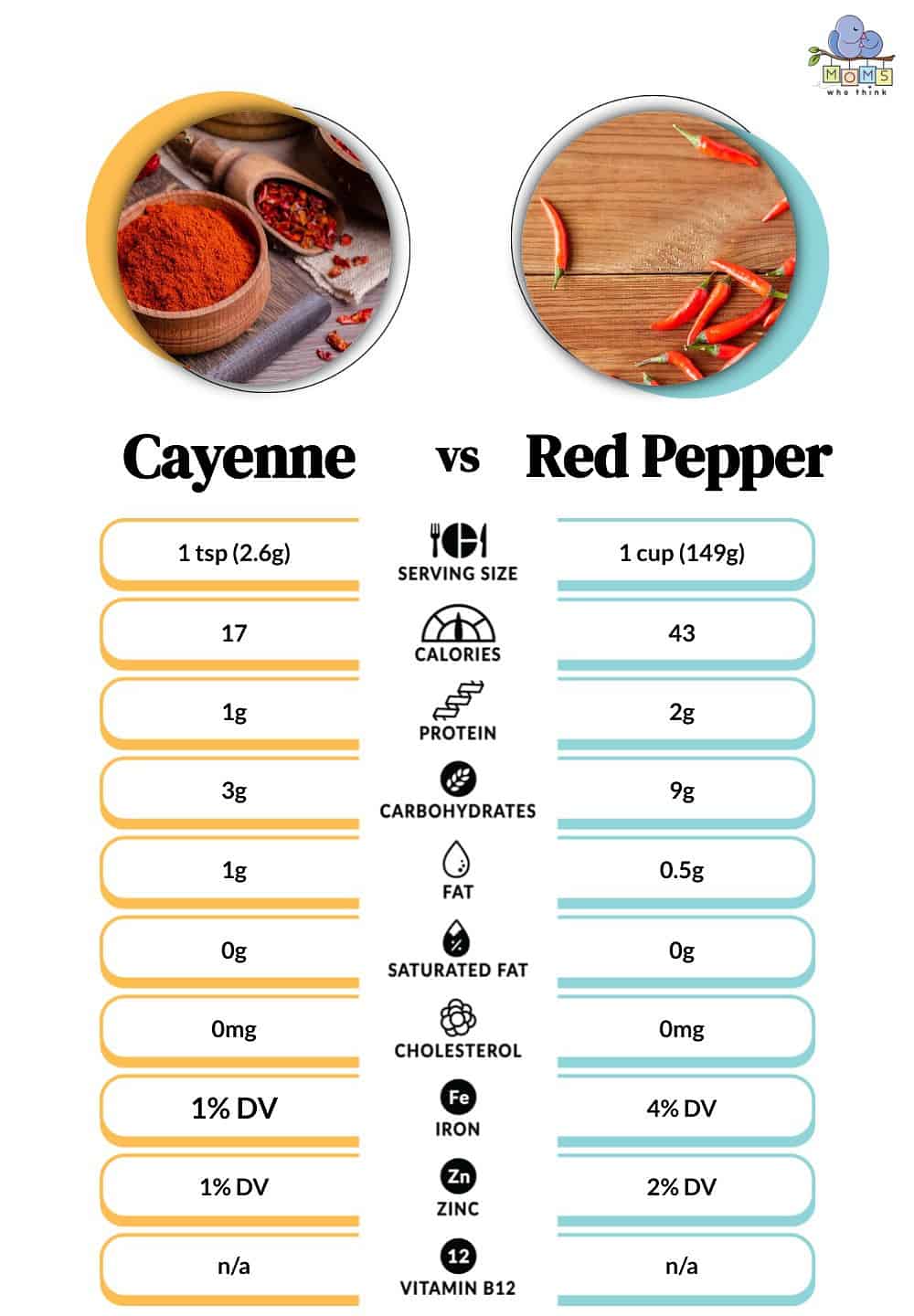
©
Can you Substitute Cayenne for Red Pepper?
Red pepper is a diverse group. Therefore it frequently works as a cayenne substitute in recipes. However, this depends on the variety of red pepper you pick. Observing a red pepper with a Scoville scale rating similar to cayenne can be beneficial as it has spiciness. It's okay to use chilies or habanero instead of cayenne peppers.
- The must-have convenient reference guide for every home cook!
- Includes more than 8,000 substitutions for ingredients, cookware, and techniques.
- Save time and money on by avoiding trips to grab that "missing" ingredient you don't really need.
Can You Substitute Red Pepper for Cayenne?
The usage frequency of the mentioned items is permissible, provided that they are used solely to cook heated substances. One example is that paprika is a type of red pepper that is distinct from cayenne pepper and cannot be substituted for it. It is a potential substitute for chili peppers, which possess a significantly high rating on the Scoville scale.
Is it Okay to Use Fresh Peppers to Make Pepper-Based Spices?
If the pepper doesn't affect the dish's texture, it's a go. Always consider what an individual recipe demands. Mind you that different peppers have different spiciness. So the easiest way to know if your food has enough kick is to taste it as you cook.
What are the Best Substitutes for Cayenne?
Cayenne pepper, typically powdered, is commonly used to give food a modest amount of spice. For an extra kick of a fiery flavor in your meal, try the following alternatives when cayenne is unavailable. Remember that many substitutes add heat and other tastes to your cuisine.
The top alternatives to cayenne pepper are:
- Pepper, red, crushed (Gochugaru in Korean)
- Blackened paprika
- Powdered jalapenos
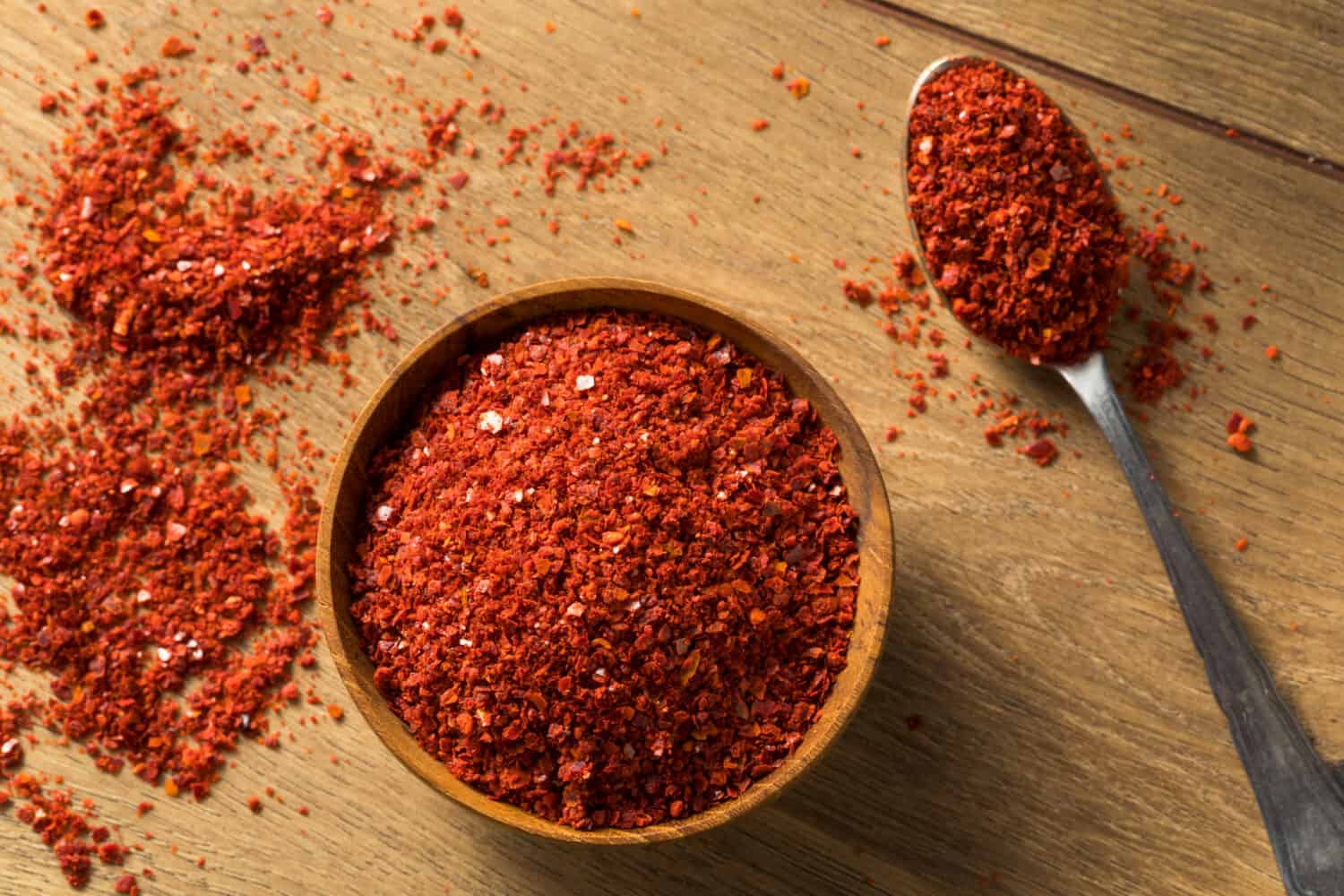
Korean red pepper, or Gochugaru, is a worthy substitute for cayenne.
©Brent Hofacker/Shutterstock.com
Grounded pepper is a good cayenne substitute. Gochugaru, or Korean red pepper, is made from crushed sun-dried red chilies. These chiles may only have 10,000 Scoville heat units, but they deliver just as much punch as cayenne. In addition to tasting great, their vibrant red hue will draw attention to your meal.
Cayenne powder is spicier than hot Spanish paprika, but you can make up the difference using more paprika. It's like cayenne powder in texture and gives food a similar red color. Pimento is a fantastic substitute for cayenne pepper if you're seeking something less intense because it comes in mild and hot varieties. You should be aware that pimento has a very distinct smokey flavor when deciding whether to add it. Fortunately, the cayenne's smokey flavor should complement the other ingredients in the dinner perfectly.
You can use cayenne pepper powder instead of chili, but the powder tastes spicier. Consider the optimal utilization of said resources. The jalapeno pepper has gained significant popularity in the United States owing to its exceptional taste and relatively low level of spice. This alternative to fresh cayenne peppers is both palatable and captivating.
What are the Best Substitutes for Red Pepper?
Paprika
Without red pepper flakes, paprika can serve as a suitable flavor alternative. Apart from its unique texture, it will not exhibit the same spiciness as chili powder. Paprika is a highly effective ingredient for enhancing the visual appeal and taste of various culinary preparations. Nevertheless, it is advisable to use it with greater frequency.
A four-fold increase in paprika relative to red pepper flakes in preparing this dish is highly recommended. It is worth noting that in the event of a shortage of red pepper flakes, paprika can be used as a substitute. According to standard measurements, red pepper flakes can be deemed as being equivalent to a quarter teaspoon, while paprika can be considered as being equal to one teaspoon. To prevent the accidental use of smoked paprika, it is essential to be careful and exercise caution. The dish's delicate smoky flavor may not match an individual's taste.
Chili Powder
If red pepper flakes are unavailable, chili powder can be a viable substitute. The flavor profile of this substance resembles red pepper flakes, albeit with a comparatively milder intensity.
The chili powder is dried, and ground chili peppers are combined with other spices. Because the flavor is pretty much the same, doubling the heat would be fantastic. Always fold red pepper flakes if a recipe calls for one teaspoon only. This option works great in baked foods.
Chile de Árbol Powder
You must be so lucky to have Chile de Arbol in your kitchen! Red pepper flakes and crushed pepper have pretty similar flavors, but the latter is a bit milder.
This spice is pretty common in Latin American and Mexican cooking. To clarify, it possesses a delightful flavor profile that lends itself well to a diverse range of culinary applications, such as incorporation into salsas, sauces, chili, stews, soups, and rubs.
If you choose to, you can do this on a one-to-one basis. A recommended proportion for incorporating chile de arbol into a recipe is adding one teaspoon for every spoonful of red pepper flakes. To reduce the spiciness of your dish, it's best to use only 50% of a teaspoon of red pepper flakes.
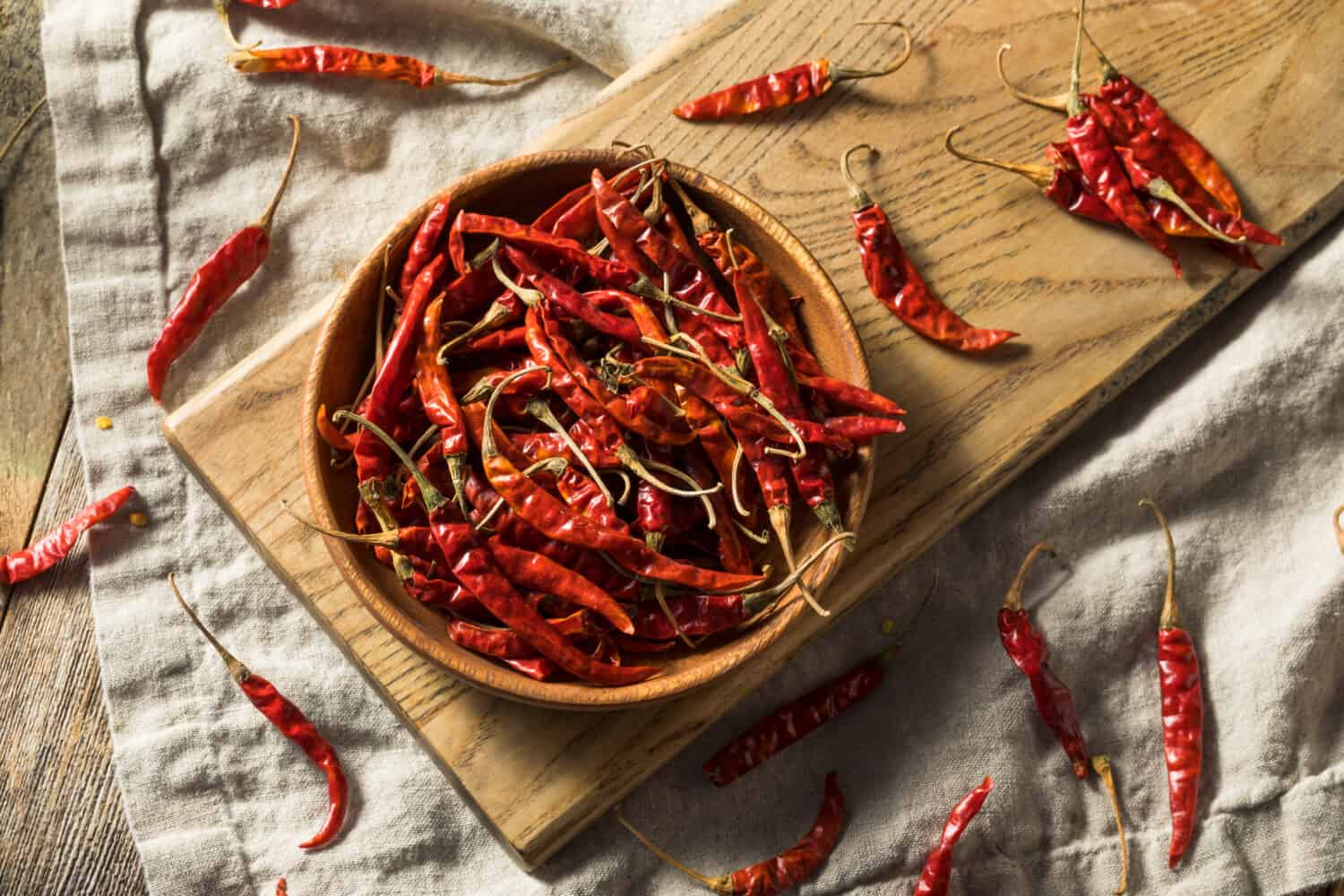
Chile de Arbol features prominently in Latin American and Mexican dishes.
©Brent Hofacker/Shutterstock.com
What is Cayenne Pepper?
Just what does the term “cayenne” mean? It is a species of plant member of the genus Capsicum. Cayenne peppers that are fully ripe will be three to ten inches long, bright red, and thin.
Cayenne peppers come in various flavors, e.g., hot “Numex Las Cruces Cayenne” to the sweeter “Cayenne Sweet.” Some red types are outliers to the rule. A rich purple shade is present in the “Cayenne Violet,” for instance. Additionally, “Golden Cayenne” is available, and as the word suggests, it is golden in color!
Cayenne peppers are pretty spicy, regardless of the kind. The mildest variety will have a Scoville rating of roughly 20,000, which is still rather potent. As a result, individuals seeking mild pepper should search elsewhere.
Cayenne Pepper Recipes
Would you like to profit from this tasty pepper? There are many methods to prepare meals with cayenne pepper. Likewise, although some prefer cayenne pepper powder, others like it straight from the garden. Whatever your taste, you probably can include them in your diet.
- Throw in some cayenne in your stew to make it spicier.
- Add a dash of ground pepper to enhance the flavor of your preferred soups or chilis.
- Enhance the flavor of your tacos by adding some ground cayenne pepper!
- One way to increase metabolism is by incorporating ground cayenne pepper into lemon tea. This simple addition can make a significant difference.
- Do you enjoy consuming sugary treats? Consider spicing up your next cup of hot cocoa by adding a small amount of chili powder. It'll give it a nice kick!
- You can sprinkle some cayenne pepper on your scrambled eggs or omelets.
- Do you have any peppers or chilis? If you want to spice up your homemade cheese, toss in a tablespoon of chili powder.
Ideas for Using Fresh Cayenne Pepper
- You can sprinkle some fresh chili pepper on your pizza!
- Next time you make tomato sauce at home, throw some thinly sliced cayenne peppers for a little extra spice!
- Throw in some chili peppers to spice up your homemade salsas.
- Put some cayenne peppers in your stir fry if you want it to have a little bit of heat.
- Get more use out of your chili pepper. You can keep them fresh for months with a food dehydrator.
- If you like cayenne in powder form, you might want to try making cayenne powder from scratch.
What is Red Pepper?
The term “red pepper” is used to describe a wide range of peppers that have a red color. Commonly, individuals use this term to refer to dry seasoning. However, in some cases, it may also denote newly harvested red peppers.
If a recipe mentions “red pepper,” it usually means something hot like chilies or cayenne. Occasionally, it may refer to less spicy peppers such as bell pepper. The interpretation of the term “red pepper” within a culinary context relies on the specific usage and context in which it is employed.
There are various advantages associated with consuming red peppers. Red peppers, regardless of their variety, are typically rich in fiber and vitamins. In case the food is spicy, the capsaicin present in it can aid in enhancing your metabolism and immune system.
Recipe for Red Pepper Dish
Do you like red peppers? Do you want to add more of this healthy element to your daily food intake? Red peppers, whether in fresh or ground form, can be a convenient and easy way to enhance the taste of your meals. They are highly adaptable, providing limitless possibilities for use in various recipes.

Both red pepper and cayenne are excellent additions to your omelets.
©OnlyZoia/Shutterstock.com
- Add some ground red pepper to your meal; it'll give it a nice pop of color and flavor!
- Don't forget about red pepper flakes! They're fantastic on pizza, pasta, or even omelets.
- If you're making your stews or tomato sauces, throw in some red pepper!
- If you want to jazz up your baked mac and cheese, throw some red pepper there for a kick!
- Why not whip up your chili sauce at home?
For fresh red peppers;
- Consider adding some crisp red bell peppers as a topping for your pizzas.
- If you want to make, red peppers taste even yummier, roast them in the oven!
- If you've got some mild bell peppers, you can chop them up and munch on them solo.
- Add red peppers and throw them on your tacos or sammies for extra flavor!
- Do you feel like making some delicious stuffed peppers, or would you rather grab something healthy to eat? You could spice up your meals with some fresh red peppers, wouldn't that be nice?
So Are Cayenne and Red Peppers the Same Thing?
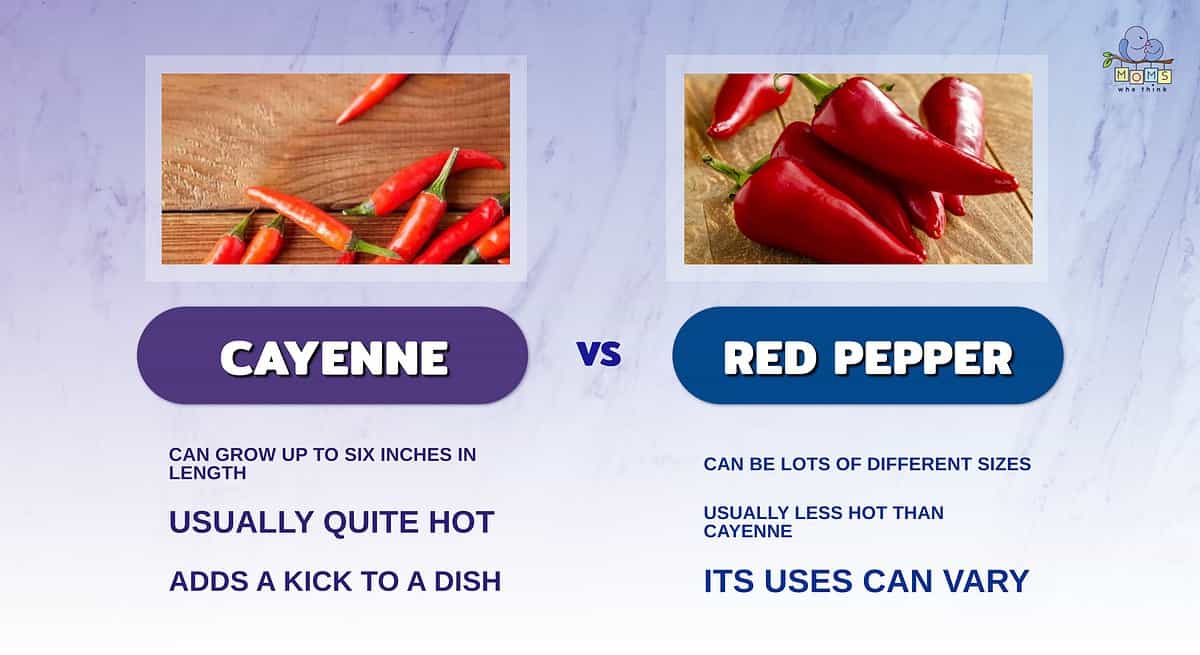
- Cayenne peppers can grow up to six inches in length, tapering at the end. Red peppers can be all sorts of sizes, depending on which red pepper in particular you are referring to.
- Cayenne peppers are known for their heat; red peppers are often less hot than cayenne, but can be hotter depending on the variety.
- How you use a red pepper will depend on what kind of red pepper you're using. Cayenne peppers are usually used to add a strong kick to a dish.
Cayenne pepper is the name of a particular plant, while red pepper is a more general term that can refer to a range of different items. Many other plants are also called “red pepper” besides cayenne pepper.
This information should be considered while deciding between red pepper and cayenne. Choose based on your taste, the meal you plan to make, and your nutritional needs.
Try this delicious New Orleans Jambalaya!
Print
New Orleans Jambalaya
- Yield: 4 servings
Ingredients
1/2 pound boneless skinless chicken breasts, cut into 1 inch pieces
2 large onions, chopped
1 cup chopped green pepper
1 celery rib, chopped
2 jalapeno peppers, seeded and finely chopped
3 garlic cloves, minced
1 Tablespoon canola oil
2 cans (14 1/2 ounces each) diced tomatoes, undrained
1/2 cup water
2 teaspoons dried thyme
1 teaspoon salt
1/2 teaspoon pepper
1/4 teaspoon cayenne pepper
1 pound uncooked medium shrimp, peeled and deveined
2 cups cooked long grain rice
Instructions
1. In a large saucepan, sauté the chicken, onion, green pepper, celery, jalapenos and garlic in oil until chicken is no longer pink.
2. Add the tomatoes, water, thyme, salt, pepper and cayenne; bring to a boil.
3. Reduce heat; cover and simmer for 15 minutes.
4. Add shrimp; simmer 6 to 8 minutes longer or until shrimp turn pink. Stir in rice.
Nutrition
- Serving Size: 3 cups
- Calories: 344
- Sodium: 753mg
- Fat: 6g
- Saturated Fat: 1.5g
- Carbohydrates: 39g
- Fiber: 6g
- Protein: 32g
- Cholesterol: 252mg
